By Jack Houvouras
HQ 17 | SPRING 1994
When I was a young boy, the prospect of putting a puzzle together held little pleasure. What motivated me to try, however, was the end result: when everything was in place and, after hours of hard work, I was able to look down on the completed picture with the knowledge that I had actually done it. In preparing an article on the future of Huntington, I could think of no better analogy. Today we, as a community, face the same prospect. And while the actual process of putting the puzzle together may often seem difficult and complex, it is the end result that must inspire us to action. In examining Huntington’s future, we must realize that there is no one answer to our problems. There isn’t any one person or event that can turn things around. Instead, there are a number of different pieces to the puzzle that must be put into place and secured. That is the challenge that awaits us. That is the key to our future.
On January 6, 1994, nearly 1,000 of the community’s most concerned residents came together at Marshall University to take part in an innovative “town meeting” concerning the area’s future. Sponsored by The Herald-Dispatch, WSAZ Television 3 and Marshall University, the meeting yielded substantive talks, constructive debate and a renewed sense of optimism for the future. It also yielded six task forces that were charged with the responsibilities of finding solutions to many of the region’s problems.
It is ironic that months prior to the town meetings, the Huntington Quarterly was in the process of preparing a special issue on “The Future of Huntington.” I was struck by the notion that a sense of common purpose and urgency had permeated the community and that most, if not all, Huntingtonians felt this was a critical time in the city’s history. We had just heard the news that Owens-Brockway was closing its doors and months later we would learn that the West Virginia Belle was sailing south. It was a difficult time but, nonetheless, one that inspired us all to action.
Putting all the pieces in place is the challenge that now awaits us. And while the complexity of the undertaking can often seem arduous, imagine, if you will, that instead of just one person working on the task, there are two. Now imagine that instead of two, there are four, eight or even ten. Working together, the puzzle could be completed in sections and unified in a relatively short time. That is how we, as a community, must approach our problems. It is something that must be done not only for ourselves, but for future generations.
Huntington is extremely fortunate in the fact that the outline of the puzzle is already in place. The city boasts one of the lowest crime rates in the nation, our neighborhoods are inviting and housing costs are low. A major university is anchored within the city, recreational activities abound and our location is ideal. A beautiful park system serves the community, health care is second to none and we are blessed with a skilled, dedicated work force. But that is just the outline. What remains is filling the gaps and completing the overall picture.
Subsequently, we have identified five important areas that must be addressed to complete the puzzle. They include business, education, tourism, access and leadership.
If Huntington is to move forward, changes must occur in each of the five areas. But perhaps the most important thing that can result from this article is the simple fact that change alone will never empower this community to new heights. Instead, the answer lies in dramatic change. Too often in the past, we have made small changes, yet expected big results. That has been our failing. The only way we will ever see dramatic results is when we demand dramatic change. We must find the conviction to accept nothing less.
Of the five areas we have identified, business emerges as the most crucial. Without it, the puzzle crumbles. Understanding the role of business and its tremendous significance to the puzzle is paramount to understanding how society functions. The facts tell us that despite losing 40,000 manufacturing jobs and 7.6 percent of our population (the largest decline in the nation) in the 1980s, business still pays 60 perce.nt of the overall tax burden in West Virginia. And taxes, leveled the most on business, are what pay for our roads and highways, schools and universities, police and fire protection, welfare and workers’ compensation, and countless other socially responsible programs. As one local leader pointed out, “Business is the goose that laid the golden egg. We can’t keep choking the goose.”
But that is exactly what we have been doing in West Virginia for the last 20 years. From skyrocketing fees and taxes to increasing demands from unions, business is being strangled. Dramatic change in how we approach business is the first step in putting the puzzle back together and making our community great again.
We all have our own dreams for the future of Huntington. For me, they include seeing Marshall University continue to grow academically to the point that it is one of the most respected universities of its size in the Midwest. I would like to see Ritter Park preserved and well maintained so that my children and grandchildren will be able to enjoy it as much as I did growing up. I hope the pace and ease of lifestyle in Huntington will remain constant, but with more recreational and cultural activities for an increasing population. I would like to see the ascetics of the city improved including the restoration of our downtown, new buildings dotting the skyline and making Huntington the cleanest city in the country. I would like read to FBI statistics every year that confirm that West Virginia has the lowest crime rate in the nation. I want our health care industry to continue to grow to the point that Huntington is a nationally recognized regional medical center and a thriving retirement community. And finally, I hope to see a time when opportunity abounds so that when I stop in for lunch atJim’s Spaghetti, I see more young faces in the crowd enjoying their break from work. If we put all the pieces of the puzzle in place, all of this is possible.
In the end, however, the people of Huntington must ask themselves if they are content with their community, if they are content with the status quo. If they are not, they must be prepared to embrace and effectuate dramatic change. Then, the puzzle will begin to take shape and Huntington will finally realize its ultimate potential.
Business
West Virginia must change its approach to taxes, fees and economic development if it hopes to turn things around.
Of the many issues facing Huntington, perhaps our state’s weak business climate emerges as the most crucial piece to the puzzle. But understanding how to get the state back on track is not complex. If you talk to the people who are creating jobs, three issues come up time and time again: Workers’ Compensation reform, corporate tax reform and economic development.

Workers’ Compensation was originally created by the state as a way to provide employees with reasonable income due to work-related accidents. The fund, established in 1913, worked well until the 1970s when changes in the law and judicial interpretation tilted the scales in favor of workers’ claims. As a result, money paid into Workers’ Comp no longer equaled the money paid out and a huge deficit began to accumulate. Today, the fund in West Virginia is nearly $5 billion in debt, yielding some of the highest premiums in the country.
The single greatest factor contributing to the debt is the vast increase in the number of workers receiving PTD awards – workers who claim they have been “permanently and totally disabled” on the job. In the last 11 years, PTD awards have jumped 500 percent despite dramatic improvements in work safety.
An individual granted a PTD award will receive, on average, $21,000 per year. These benefits are tax free and equate to a pre-tax income of nearly $30,000. In addition, PTD awards are paid for life, and there is no rule against the individual being gainfully employed.
In March, a letter to the editor in The Herald-Dispatch was published that read: “My husband died last month from cancer. He fought the battle for eight months. All he wanted the entire time was to get well and go back to work. Something is terribly wrong here when I see healthy young men every day go past my house pulling boats, going to the lake to hunt and fish who are supposed to be sick and drawing Workers’ Compensation. How can you lift a boat or trailer and put it on the hitch of a truck if you have a bad back? How can you ride a four wheeler with a bad back? How can you prepare a ball field for play with a bad back? Are there any answers to my questions?” Signed, Betty Adkins, Lavalette.
“People have turned to Workers’ Compensation to fill the gap,” says EvanJenkins, general council of the West Virginia Chamber of Commerce. “It has turned into a social welfare system.”
Jenkins has been at the forefront of the battle to get the Workers’ Comp problem under control. “Our concern is that our current employers and future employers in West Virginia will be forced to pay higher premiums to cover the deficit. In recent years, our Workers’ Comp system had the highest cost per covered worker in the nation.”
Employer premiums have increased 12 5 % in the last five years, yet the deficit continues to grow. As a result, companies have left the state citing the sky rocketing rates while others are reluctant to move here for the same reason.
Last year Jenkins pushed hard at the legislature for major reform in the area of PTD but had to settle for the creation of a Performance Council to study the PTD issue and find ways to eliminate the fund’s deficit. However, to date, nothing of significance has been done to solve the problem. In fact, the deficit is still growing.
“If someone gets hurt on the job, we must compensate them and compensate them fairly,” says Jenkins. “But, we have to keep in mind the way other states handle Workers’ Comp. After all, we have to compete with their companies.”
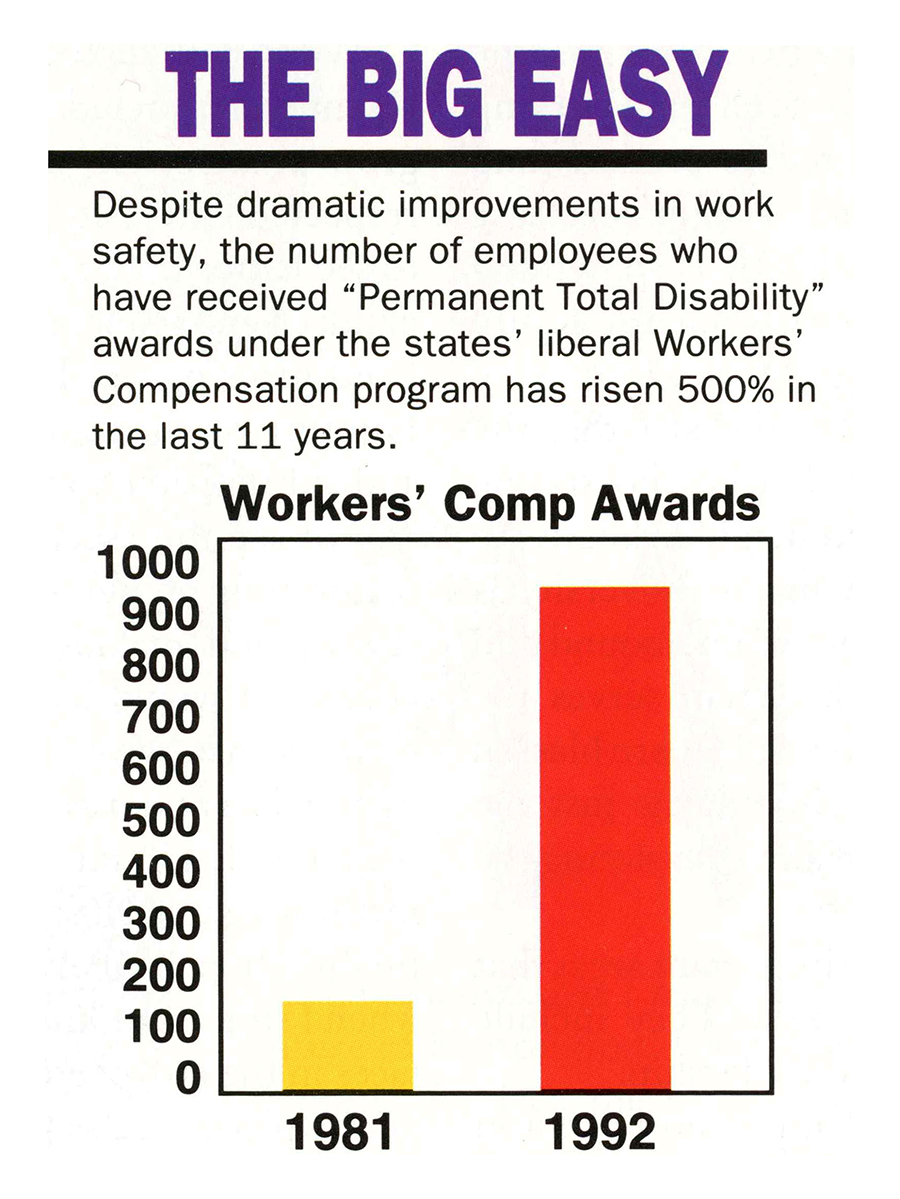
In addition to Workers’ Comp woes, West Virginia must also contend with its corporate net income tax rate which is one of the highest in the nation. In fact, West Virginia has the unenviable privilege of having the highest rate in the southeast at 9 percent and the 8th highest in the nation. And considering that companies often use tax levels to gauge a city or state’s attitude towards business, these rates, combined with Workers’ Comp fees, make West Virginia an unattractive prospect. Both problems have been examined by the legislature in recent years with labor unions fighting Workers’ Comp reform and state government fighting a reduction in taxes for fear that their funds will dry up. “Government needs to have confidence in the busi-ness owners that if taxes are cut, economic activity will increase and additional revenues will be gained,” notes Steve Roberts, president of the West Virginia Chamber of Commerce.
In order for Huntington and the state to move forward, West Virginia must foster a more competitive business climate. Otherwise companies .like Owens-Brockway will continue to shut down and countless others will pass on moving their operations to West Virginia. Case and point: On Feb. 3, 1994, State Electric, one ofHuntington’s greatest business success stories with more than 5 00 people employed in West Virginia, announced that it needed to expand but may have to do so elsewhere. “I don’t want to move to another state,” said Art Weisberg, the company’s founder and chairman. “My wife and I have lived in Huntington for 42 years. We’ve raised our family here. But, because of the tax situation here, we have to consider it.” An analysis done by State Electric’s accounting firm found that the company would pay more than twice as much to operate in Huntington than in comparable cities in Kentucky and Ohio.
In recent years, economic development has become the buzz word in communities looking to turn things around. Huntington has been no exception. However, the approach we have taken has often been misguided. While economic development gurus have often talked about “retention, expansion and recruitment,” the truth of the matter is that in Huntington, 99 percent of their efforts have been exhausted on recruitment alone. In many ways, you can’t blame them. Announcing that l00new jobs are coming to town is far more glamorous, and newsworthy, than helping a small business double its work force from ten to 20 employees. Consequently, development officials have preferred to throw their fishing lines in the national pond as opposed to fishing in their own backyard. They have failed to see the simplicity in the knowledge that helping ten companies with ten employees double their work force 1s the same as bringing in a company with 100 new jobs. And, most importantly, they have failed to see that 96 percent of all companies in West Virginia employ 50 or fewer people.
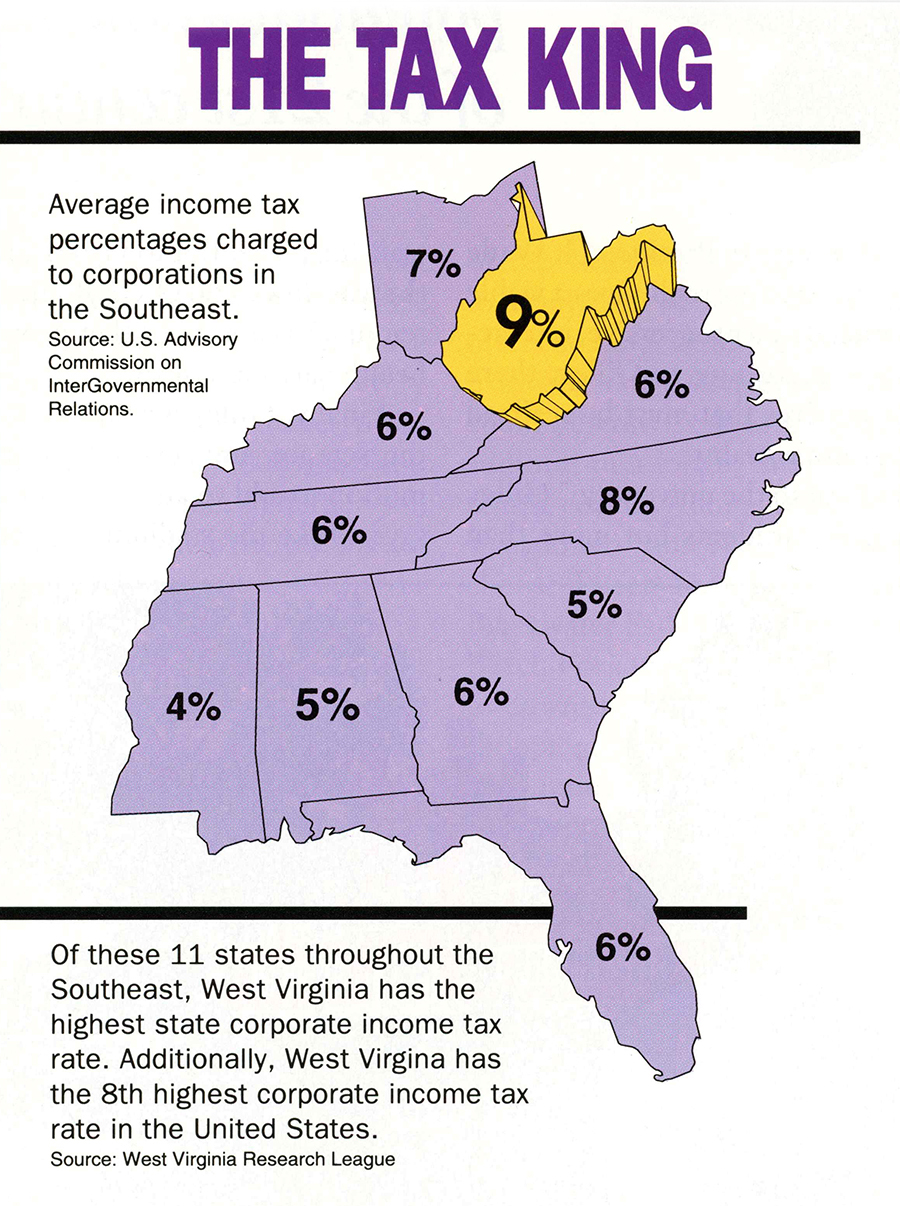
Huntington’s latest effort in economic development is headed up by Gerald McDonald. McDonald, president of the recently formed Huntington Area Development Council (HAD CO), recognizes the miscues of the past and has vowed to concentrate on going after smaller companies. “The days of attracting companies that create thousands of new jobs are gone,” says McDonald. “In the future, growth in new jobs will come from companies employing 25 to 200.”
McDonald cites the availability of a large, skilled and stable work force as one of Huntington’s greatest strengths. And as for expansion, he sees growth in health care, telecommunications, environmental research, light manufacturing and wood products. But he is quick to downplay his role.
“I’m not going to save this community,” McDonald asserts. “The community is going to save itself.”
Education
Marshall University holds the key to unlocking Huntington’s potential in the high tech fields of the 21st century.
When Marshall University President J. Wade Gilley looks into the future, he sees a viable community fueled by a progressive, interactive university. According to Gilley, there are three imperatives that must be realized to make his vision a reality.

“A new library is absolutely critical to the university,” Gilley insists. “We need more space for students but more than anything else we need to be a part of the worldwide information highway so our students can visit everyone from the Library of Congress to the University of London. A new library will bring the world right to our fingertips.” Construction of a new $14 million state of the art library has enormous consequences for the university and the community. Through the digital and fiber optic network that is already in place in West Virginia courtesy of Bell Atlantic, the university is in a position that would allow every public school, every public library and every interested citizen to access the world through the facility.
The Marshall University Medical Center, a proposed $28 million, six-story project to be built adjacent to Cabell Huntington Hospital, is second on Gilley’s list and calls for the construction of a new ambulatory care unit, a rural health care center, a health sciences library and offices for physicians, faculty and residents. “This center will lift our medical school to a whole new level,” Gilley says. “All of which will transform Huntington from Cabell Huntington Hospital all the way down Hal Greer Boulevard to 20th Street. In the next ten or 15 years, all of that property will be transformed into health care complexes.”
Finally, Gilley would like to see a dramatic upgrading of the science and technology programs. “We’ve spent $30 million to add to and renovate our science facilities,” Gilley says. “Like the stadium, it’s second to none. What I would like to do now is crank up our department and expand with programs including environmental science, biomedical science, manufacturing – a whole new generation of science programs that will allow our students to work in the emerging industries and provide the manpower that will attract new companies.”
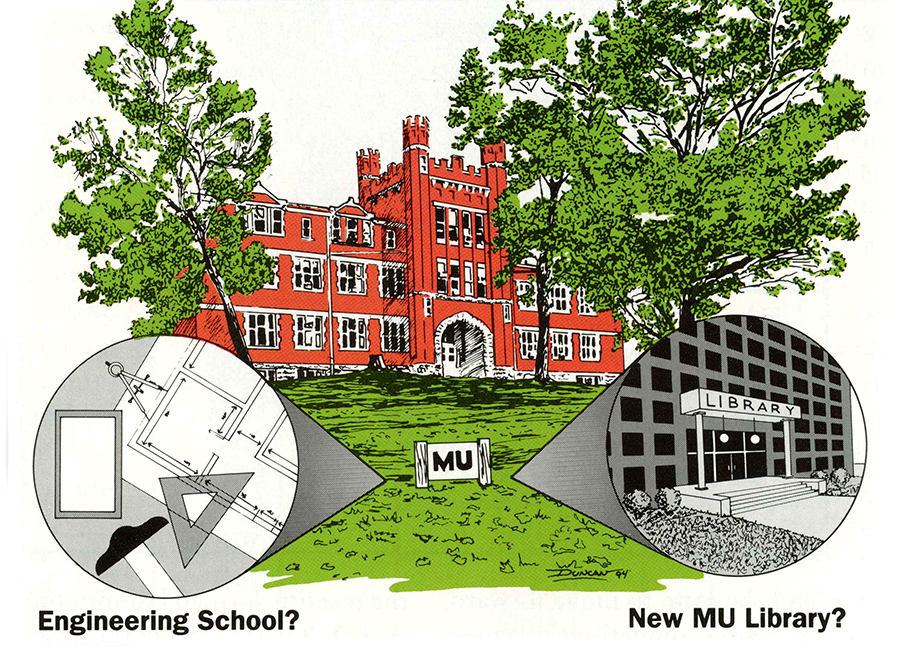
As for ongoing efforts to initiate an Engineering School at Marshall University, Gilley prefers the idea of creating a “Science and Technology” degree that would prepare students for the high tech fields of the 21st century. “In the next century, everything will be about brain power and I want our students ready to compete,” Gilley asserts. Finally, he wants the university to be on standby to assist local business with their problems.
As Gilley points out, “The university is an example of the symbiotic relationship that must exist between the university and the community.”
Tourism
Huntington and the Tri-State have a lot to offer, but without a major draw the crowds will never come.
Crowds. That’s what tourism is all about. On March 4, 1994, the West Virginia Legislature sank a Riverboat Gaming bill that would have brought the crowds to Huntington and every other river city in West Virginia. In fact, those crowds would have created 7,000 jobs and generated $50 million in tax revenues alone. Whether you were for or against riverboat gambling, the basic premise of the defeated idea is still an issue – Huntington will never cash in on tourism unless it develops a major draw.

Over the years, numerous plans to develop such a draw in Huntington have been snubbed. Local leaders never lent any real support to a proposed riverside marina and the idea for an outlet mall never gained any momentum. It’s hard to say how many other ideas have fallen by the wayside.
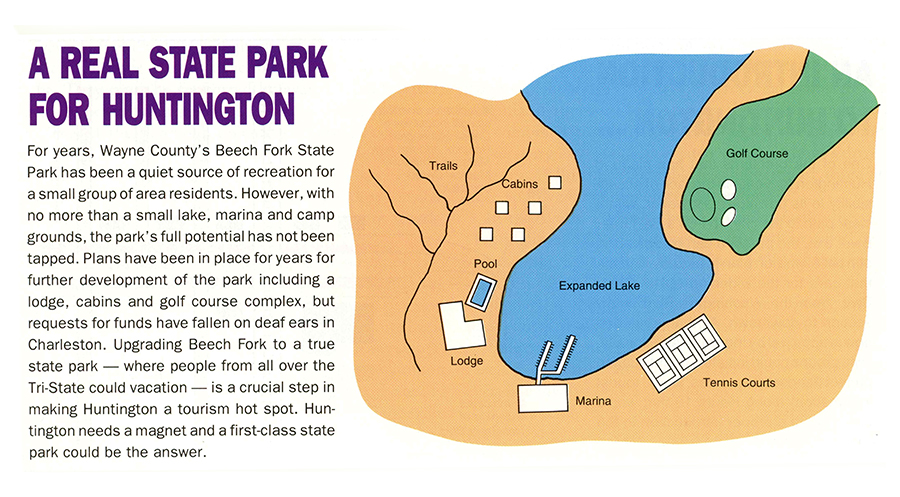
Most recently, attempts have been made by a small group of local leaders to expand Wayne County’s Beech Fork Lake to a full-fledged state park. Currently, the small state park offers boating, camping and little else. However, with funds from the state’s Division of Tourism and Parks, Beech Fork could be converted into a local tourist attraction with the addition of a lodge, cabins, swimming pool, golf complex, tennis courts, riding trails – the possibilities are endless. Vacationers from West Virginia and surrounding states could choose Beech Fork just as easily as they could Pipestem, Blackwater Falls and other state parks. But what would make Beech Fork unique would be the ease of access (15 minutes) to downtown Huntington. Vacationers could also do some shopping, take in a movie and do some sight-seeing. There are a number of good ideas to help tourism in Huntington. However, until we find a major draw, tourism will never be a factor in Huntington’s economy.
Access
Making it convenient for big business and local shoppers is the name of the game in the infrastructure strategy.
From the day construction was completed on Interstate 64, travelers have had a difficult time finding their way to downtown Huntington. It is an example of the problems that plague our infrastructure, both in terms of planning and alteration, that local leaders must address. Until we do so, the city will continue to be passed over.

Today, however, infrastructure is about more than just highways and roads. It also encompasses the areas of air service, water, sewer, power and, most importantly, the potential for economic development.
In Huntington, identifying a clear path to the city from the interstate is a decision that must be made if our downtown is to realize its potential.
In addition, business and transportation issues come into play when you consider the need for an accessible thoroughfare for trucks and heavy equipment vehicles.
David Riedel, with Ferguson Enterprises of Huntington, contends that the larger trucks that service his company are not able to travel easily through the city because of the bad planning of the past. “We must find a way to eliminate our isolation from the rest of the business world. We need to find a way to get the interstate traffic in here.”
Currently, a plan is in place that could solve the accessibility dilemma. The $9 million project would widen Hal Greer Boulevard into five lanes from the Washington Boulevard intersection to the downtown. The viaduct would also be revamped to make way for larger vehicles.
Another essential element in strengthening the infrastructure is road improvements within the city. In recent months, the city has been widely criticized for the lack of upkeep on its thoroughfares. The dilapidated and abused streets are not only an eyesore, but cause damage to the vehicles that must maneuver through the maze of potholes.
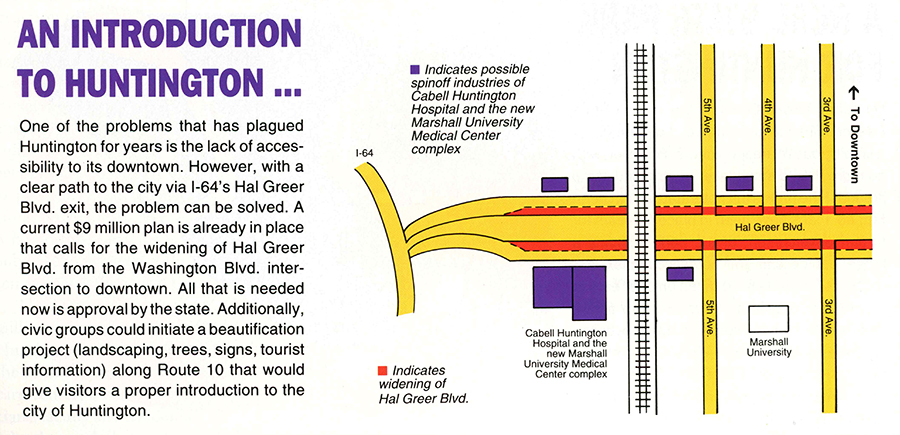
Therefore, if we upgrade accessibility into Huntington only to have visitors dismiss the city because of poor street conditions, then we are defeating the overall purpose.
Although the need exists to improve our current infrastructure in and around Huntington, perhaps nothing is more crucial than developing the region via a new interstate. A current proposal in Washington calls for the construction of a new highway, I-73, that would run from Detroit, Mich., to Charleston, S.C., with a stretch of the road connecting Huntington and Bluefield. Should the project receive approval, Huntington would have both I-64 and I-7 3 in the immediate vicinity, bringing more visitors and industry to the Tri-State. Congress is expected to decide on new roads this year. Hopefully, I-73 will get the go ahead.
But roads alone will not solve the region’s infrastructure plight. They must be supported by available land, sewer, water and power to stimulate economic development.
“One of the biggest problems we have in economic development is that even if a company wanted to locate in the state we literally don’t have a place for them,” says House Speaker Chuck Chambers. “We don’t have buildings or sites available. We don’t even have the infrastructure (roads, water, electricity) to develop sites.”
Huntington could certainly learn from other cities who have encountered similar dilemmas. In the 1980s, Scottsville, Ky., faced a staggering unemployment rate of 20 percent. Rather than mull over their problems, the community initiated a number of improvements to their infrastructure. Foremost in their plans was the development of a $1.6 million sewer treatment plant that would service both the private and industrial sectors. With the proper system intact, Scottsville has since welcomed three new plants to the area and has seen the county unemployment rate drop to 4.8 percent, proving that a strong infrastructure can only serve to better a community.
Creative solutions to infrastructure improvements also abound in our own backyard. Sen. Bob Plymale, D-Wayne, has come up with one of the best in recent years. His idea, TIPP, Total Infrastructure Planning Program, would combine economic development with highway projects.
“While you’re planning a road, why don’t you plan for sewers and water on that road?” Plymale asks. “It doesn’t make sense to build a highway through an area, and then ten years later develop an industrial park. Why not do it at the same time?”
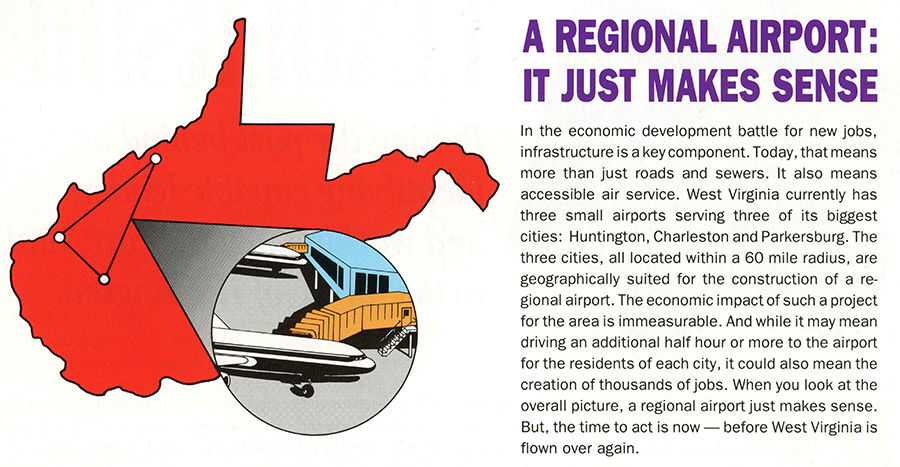
Plymale’s colleague in the legislature, Sen. Ned Jones, D-Cabell, has some solutions of his own that could bring unbridled growth to the region.Jones has been at the forefront of a local movement to bring a regional airport to West Virginia. If approved by Congress, the facility would serve the combined populations of Huntington, Charleston and Parkersburg and would be located within an hour’s drive of each city. Following a favorable feasibility report, three sites were approved, but none formally endorsed.
In the 1960s, a plan to build a similar facility between Huntington and Charleston was defeated by Kanawha County voters. But thanks to Rep. Bob Wise, D-W.Va., the idea has been resurrected in Washington.
“Federal money is going to be spent on airport construction,” notes Wise. “The only question is where?”
“We don’t want to be left out again,” says] ones. “Why not reach a consensus and put the site where it could help everyone involved instead of one city?”
To that end, Jones urges a spirit of cooperation between the three cities and warns that we must begin planning now if we hope to land the mammoth federal project.
Leadership
Putting the past behind us, identifying capable leaders and working together are vital to the future of Huntington.
Per haps one of the greatest failings in Huntingon’s past has been our inability to work together effectively. Our own history has taught us that division, class or otherwise, has been the single greatest factor in keeping the community from realizing its potential. Bu that was the past. The time has finally arrived in Huntington to move forward. At the center of the community’s renewed effort to turn things around is the issue of leadership. Who will oversee the process of putting all the pieces in place is a question we must ask ourselves. From local task force members to state legislators, Huntington must find capable leaders to prepare us for the future.

In addition, to piece together a complex puzzle, a strong network must be in place to oversee the process. To that end, the editors of the Huntington Quarterly Magazine suggest the formation of a “Huntington Round Table.” The organization’s goal would be to bring together different factions of the community. While there are numerous groups to consider for the organization, we have identified ten that should be included. The entities are:
• Huntington Regional Chamber of Commerce
• United Huntington Industries (UHI) – Tom Scott’s venture capital group
• Marshall University
• Huntington Area Development Council (HADCO) – Huntington’s economic development organization
• City government
• County government
• State government
• Federal government
• Local banks
• Unlimited Futures Inc. -Joe Williams’ small business incubator
Ideally, representatives from each of the groups would meet on a monthly basis to address the most pressing issues facing the region. Then, courses of action would be charted, implemented and monitored on a continual basis.
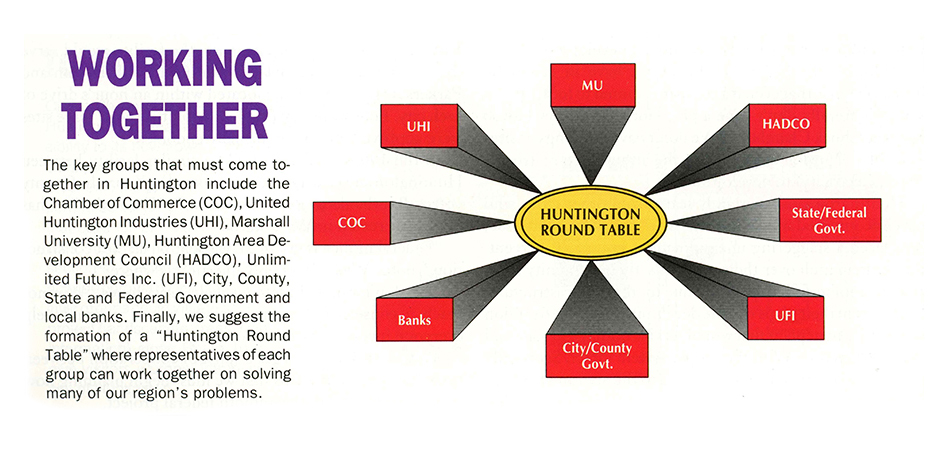
“We need to get everybody on the same page sharing a common vision,” notes Gerald McDonald, president of the Huntington Area Development Council. “We need less division and more team work. We must eliminate any “turf” issues. In order for us to maintain parity with business recruitment elsewhere around the nation, we must forge a· new spirit of cooperation. Working together we can make it happen.”
The task force effort already begun by The HeraldDispatch, WSAZ Television 3 and Marshall University could be used effectively in conjunction with the new organization. Task force leaders could report to the Round Table and from these meetings, courses of action could be initiated. It is an idea that not only makes sense, but compliments the community efforts to date.
The strength of the round table concept lies in its sound organiztion and power to effectuate change. A variety of interests from throughout the community would have the unique opportunity to come together as one. Participants ranging from members of the organizations’ board of directors to task force volunteers to interested citizens would share in the role of preparing Huntington for the 21st century.
With leadership comes a tremendous responsibility. Nowhere is this more apparent than in the manner in which we prepare our youth for the future. For years, ,business leaders have recognized the need to introduce a supplemental program on the capitalistic free enterprise system in area schools. The need for programs like Junior Achievement has never been more evident than today. While schools seem to be doing an adequate job preparing students for the future on a number of different fronts, the one area that is most neglected (and which is probably the most critical) is studying our country’s capitalistic free enterprise system. Understanding the workings of business and how it applies to everyone – management, labor and the average voter-is key to developing cooperation and promoting progress. To that end, Junior Achievement of the Tri-State has been working for years to raise the funds and find the volunteers to bring such educational programs to the classroom. But their efforts must be stepped up if every student in the region is to benefit from understanding our economic system.
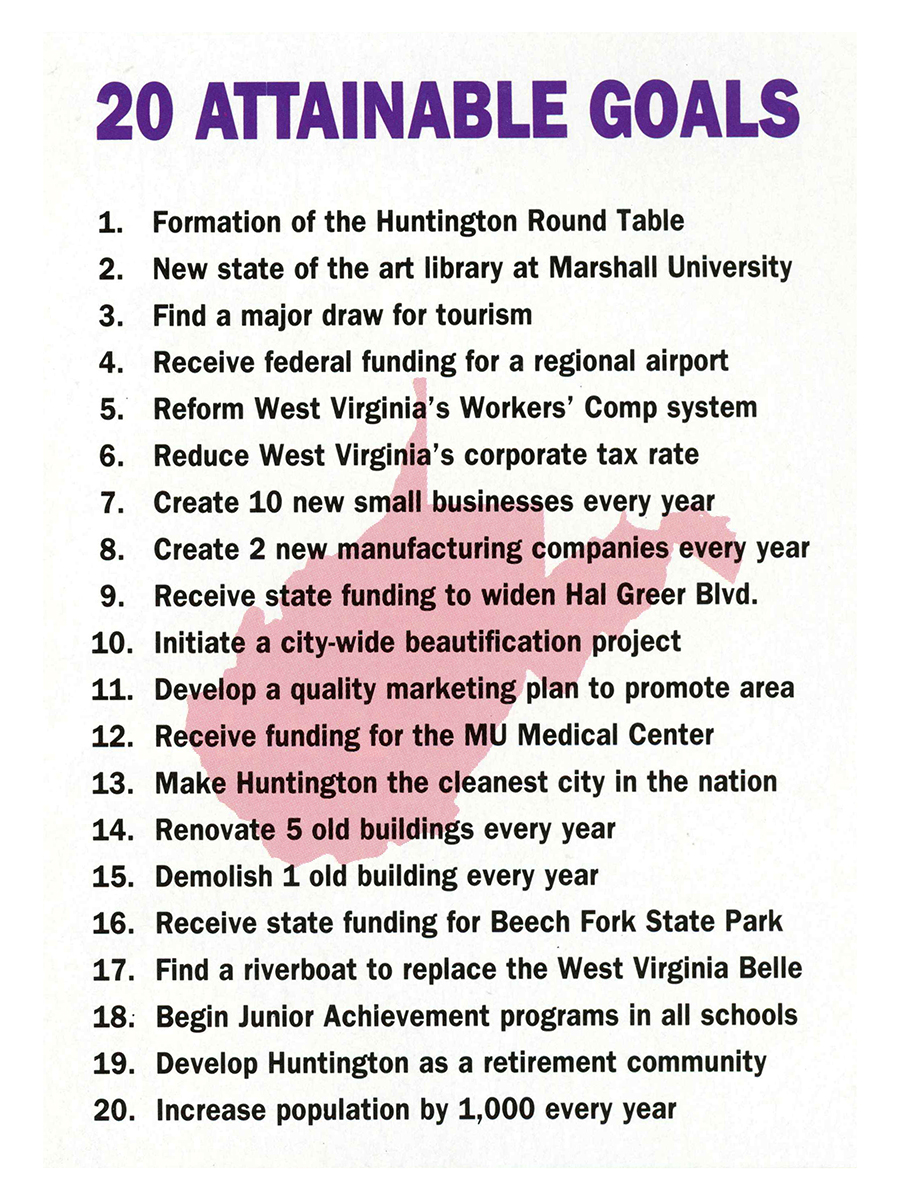
When I was a young boy, I remember the start of every school year my father telling me, “The future belongs to those who prepare for it.” He understood then the importance of organization and being ready to take on the challenges that await us.
If Huntington is to move forward, then these same principles must apply. The efforts already underway by The Herald-Dispatch, WSAZ Television 3 and Marshall University (and the task forces that have resulted) are an important first step. The Huntington community has demonstrated its ability to come together. Now if we can only foster a climate where we can continue to work together, not just in the coming months, but the coming years, our vision of the future will begin to take shape.
The time has come to begin putting all the pieces in place. The puzzle has been laid out before us. All that remains now is that we find the conviction to effectuate dramatic change so our dreams of a higher quality of life for the region will come to fruition.





